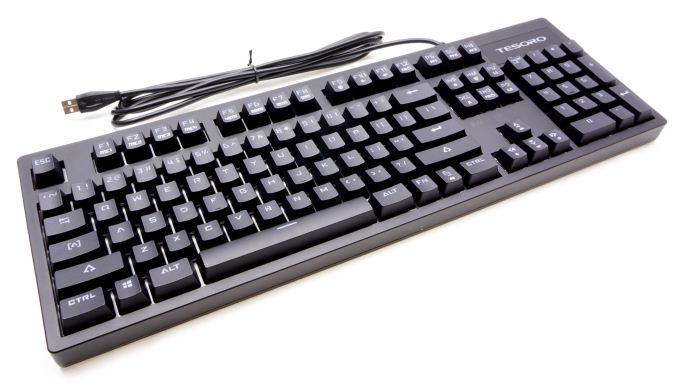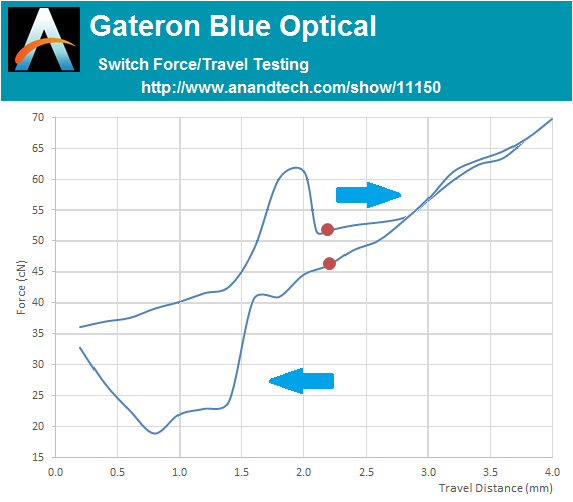The Tesoro Excalibur SE Spectrum Review: A Mechanical Keyboard with Gateron Optical Switches
by E. Fylladitakis on March 20, 2017 9:00 AM ESTConclusion
The Tesoro Excalibur SE Spectrum is a very interesting keyboard and the first product that we have seen making use of optical technology to generate actuation/reset signaling. The concept is interesting and our testing proved it to be a viable alternative to typical mechanical switches that rely on electrical contacts. This does eliminate issues that can be caused by the deterioration of the metallic contact leaves of the mechanical switch, such as misclicking and corrosion. There is a metallic leaf inside the Gateron Optical switches as well anyway, but it is there only to emulate the movement and feedback of the mechanical switch.
Even though the Gateron Blue Optical switch does copy the regular mechanical switch in terms of force, the infrared sensor actuates and resets the switch at a specific travel point, ignoring the state of the metallic parts. This specific behavior can be very useful to gamers, as the switch does not have to reach the actual reset point of the classic mechanical switch variant that is almost 1 mm above the actuation point, making rapid and continuous keystrokes easier and more reliable.
Aside from its switches, the Excalibur SE Spectrum actually does not have any other features that really stand out. It is a well-made, robust mechanical keyboard with a subtle design, but it lacks advanced features that many other keyboards around its price range currently offer. The concept of making it plug & play, allowing the user to program lighting modes and macros without relying on software, is interesting and may be useful to some. At the same time however it is very limiting, coercing the user to be content with simplistic keystroke macros and basic lighting effects. The RGB lighting is very basic and limited to just a handful of colors as well. It is unlikely that advanced gamers will be satisfied by the capabilities of the Excalibur SE Spectrum, unless if they are playing games that never rely on macros and other advanced commands.
The Gateron Blue Optical switches are very interesting but it seems that their cost is currently too high for them to form a truly competitive product. Tesoro’s effort with the Excalibur SE Spectrum did form a solid, reliable mechanical keyboard that will not disappoint in terms of quality and performance. Its currently retail price of $100 however is a bit on the high side for its features and capabilities, as fully programmable keyboards capable of much more complex functions and using original Cherry MX switches can be found selling around this price point. We do however hope that Tesoro will be designing and presenting more keyboards making use of the optical switches in the near future, especially top-tier models with advanced features and improved software support.













21 Comments
View All Comments
MobiusPizza - Monday, March 20, 2017 - link
Currently, the only advantage over mechanical contacts apart from shorter travel. What they should aim for is programmable characteristics such as what travel distance activates the switch, as the sensor is capable of measuring the analogue movement.WorldWithoutMadness - Monday, March 20, 2017 - link
This one won't chatter like the traditional one.Kutark - Thursday, April 6, 2017 - link
So is it significantly quieter than a mechanical? I have a friend who continues to buy these horrifically bad Chiclet type keyboards because they have a very low actuation distance and are relatively quiet. He bitches constantly about how loud my keyboard is, so I can't even get him to try one out because of that.This sounds like it might be a good alternative option?
Old_Fogie_Late_Bloomer - Monday, March 20, 2017 - link
The advantage is that you don't need to wait for the switches to settle before decoding a keystroke, which in theory should lower latency. I dunno if that will really benefit anyone but competitive Korean StarCraft players, but that's the point of them.I use a Code Green primarily for my personal computing, where as long as I don't get strokes registering twice I'm happy and don't care about the slightly longer latency. But I'd definitely be interested in a red-equivalent optical switch for gaming (I have a Gateron Brown board for this but haven't had a lot of time to play lately).
Personally, I don't know why anyone markets blue switches to gamers, but obviously people are buying them. I find the mechanics of MX Greens to be an impediment for twitchy play, myself.
KAlmquist - Monday, March 20, 2017 - link
Why is it necessary to “wait for the switches to settle before decoding a keystroke?” When a mechanical switch closes, the contacts can bounce, causing the switch to open and close several times. So, the first time a switch closes, the keyboard reports the closing of the switch as a keystroke. The keyboard logic then has to identify the subsequent openings and closings as caused by contact bounce, which it does based on time. So the debouncing logic in the keyboard shouldn't introduce latency unless you manage to type quickly enough to confuse the debouncing logic. In particular, if you press a key and then release it really fast, the switch open caused by releasing the key could be confused with a contact bounce, causing the keyboard circuitry to delay reporting the key release until a timeout causes it to realize that it's not observing a contact bounce after all. But that's a delay in reporting a key release, not a key press, and I doubt that it happens in practice.sor - Tuesday, March 21, 2017 - link
A required delay in a key release is also a delay in the next key press. Probably not really any issue in practice, however, unless you like to type the same character at a rate of 100/second or more.sor - Tuesday, March 21, 2017 - link
For both keyboards it's required that the key travel backward 2mm to register a release, that's probably the limiting factor and introduces more than enough time to register debounce.SodaAnt - Monday, March 20, 2017 - link
How is the PWM on the RGB LEDs? I've seen a few keyboards where you get the rainbow effect if you move your vision on the keyboard too quickly, and the colors all end up splitting because the refresh rate is so low.pjcamp - Monday, March 20, 2017 - link
"The concept of making it plug & play, allowing the user to program lighting modes and macros without relying on software, is interesting..."I need to correct your typo here. It is not an interesting feature, it is REQUIRED in order to fully function with operating systems other than Windows. The folks down at Anandtech should recognize the existence of people who use Linux and Macs. When I bought my last keyboard, I spent a long time pouring over technical docs specifically to find one that was independent of Windows.
twtech - Monday, March 20, 2017 - link
And yet still, there is no MS Natural type split keyboard equivalent with mechanical keys. Considering the MS Natural shape & style remains the keyboard style of choice for many programmers and others that type all day, it seems like this should have been an obvious market to target.There are a few ergonomic mechanical keyboards, but most of them have nonstandard key layouts. There's the Matias Ergo Pro, which has a mostly-standard layout - and is what I'm using now - but it has some quirks with stuck keys, etc., comes in two separate halves connected by a wire, and is very thick (when tented it sits up over 2" off the desk in the center).
With all these generic mechanical keyboards coming out that are mostly all the same, you'd think someone would want to capitalize on the not-so-niche market of people who type all day and are willing to shell out the $150+ that many of these mechanical keyboards cost, but who also must have a split-style keyboard.